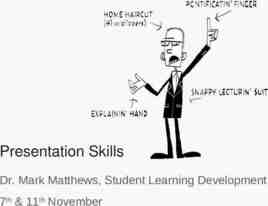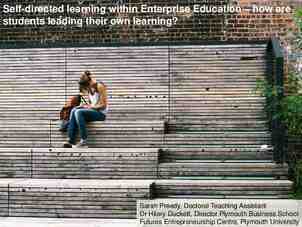Field Experiences: Preparing Students to Support Each Young Learner
38 Slides5.24 MB
Field Experiences: Preparing Students to Support Each Young Learner
Introductions
Sponsored by ACCESS Featuring Nancy Beaver (TX) Cheryl Bulat (IL) Camille Catlett (NC) Ana DeHoyos-O’Connor (TX) Nancy Gabriel (NY) Elizabeth Golen-Johnson (WA) Elisa Huss-Hage (OH) Sharon Little (NC) Carrie Nepstad (IL) Melanie Nollsch (IA) Susan Simon (IA) Terri Sinclair (TX) Mary Skinner (WA)
Handouts are online http:// fpg.unc.edu/presentations/field-experie nces-preparing-students-support-each-y oung-learner
Today’s Opportunities Getting Grounded Definitions NAEYC guidance Recent evidence Points of Pride/Places for Progress Table Top Discussions (x3) Panel Discussion Back Home Planning Evaluation
Field Experiences Internship Lab Clinical Experiences Practicum Observation Student Teaching
NAEYC Guidanc e
What is NAEYC Standard 7?
Criterion 5: Quality of Field Experiences The program’s field experiences support candidates’ learning in relation to the NAEYC standards. Rationale: Candidates will understand and apply the competencies reflected in the NAEYC standards when they are able to observe, implement, and receive constructive feedback in real-life settings.
Excerpt from NAEYC Early Childhood Associate Degree Accreditation Handbook (Page 33) Indicators of strength: - Field experiences are consistent with outcomes emphasized in NAEYC’s standards, are well planned and sequenced, and allow candidates to integrate theory, research, and practice. - When the settings used for field experiences do not reflect standards of quality, candidates are provided with other models and/or experiences to ensure that they are learning to work with young children and families in ways consistent with the NAEYC standards.
Indicators of strength: (continued) Faculty and other supervisors help candidates to make meaning of their experiences in early childhood settings and to evaluate those experiences against standards of quality. - Adults who mentor and supervise candidates provide positive models of early childhood practice consistent with NAEYC’s standards. - Field experiences expose candidates to a variety of cultural, linguistic, and ethnic settings for early childhood care and education. - Field experiences provide opportunities for candidates to observe and practice in at least two of the three early childhood groups (birthage 3, 3-5, 5-8) and in at least two of the three main types of early education settings (early school grades, child care centers and homes, Head Start programs).
Excerpt from NAEYC Early Childhood Associate Degree Accreditation Handbook (Page 79) Field Experiences and clinical practice: Includes field observations, field work, practica, candidate teaching and other “clinical” practice experiences such as home visiting. A planned sequence of these experiences supports candidate development of understanding, competence and dispositions in a specialized area of practice. Excerpt from Self-Study Report template for first-time accreditation (Page 20) Sources of evidence: 1) Report: - a one- to two-page description of program’s approach to using field experiences. - program chart of field experiences (see example below) - a one-page description of plans to address challenges and build on current strengths in this area. 2) Site Visit: Interviews with faculty, candidates, cooperating teachers, and other supervisors
Excerpt from Self-Study Report template for first-time accreditation (Page 21) Please provide a one- to two-page description of program’s approach to using field experiences: Please provide a program chart of field experiences (see example below): Sample program chart of field experiences Location/Setting # Hours Age Group Assignments Field Experien ce #1 Field Experien ce #2 Please provide a one-page description of plans to address challenges and build on current strengths in this area:
Chart of field experiences Owens Community College: Early Childhood Education Technology degree (0) observation (P) practice Core Course Location/Setting # Hours Age Group Assignments 10 hours ECE 100 Intro to ECE Child Care Centers Preschools Head Start Community agencies Professional organizations Birth-age 3 3-5 years 5-8 years Center Observation visit (O) Service learning activity (P) Professional Development Assignment (O) Public Preschools Public/Private/ Charter Schools Inclusive settings 12 hours 3-5 years 5-8 years Classroom Visits (O) (2 different age groups in two different settings) Child Care Centers and Homes Preschools Head Start -Public/Private Charter Schools 5 hour minimum Birth-age 3 3-5 years 5-8 years Infant/Toddler Observation (O) Conservation Observation (O) School Age Topics Exploration (O) Literacy Training Programs -Public/Private Charter Schools -Community Agencies 10 hour minimum 5-8 years Literacy Tutoring Documentation (P) Literacy Environment Assessment (O) Child Care Centers and Homes Preschools Head Start Public/Private/ Charter Schools 20 hours 3-5 years Case Study (P) Mock Parent Interview (P) Child Care Centers and Homes Preschools Head Start Public/Private/ Charter Schools 5 hour minimum Birth-age 3 3-5 years ITERS (O) Infant/Toddler Activity Plan (P) EDU 100 Intro to Education EDU 101 Child Development ECE 104 Emergent Literacy ECE 106 Assessment and Observation in Education ECE 109 Play, Learning and Environments
Anecdotal Evidence High quality field experience sites are hard to find High quality inclusive field experience sites are even harder to find from Camille’s conversations with faculty across the country
Finding A lack of distinction among labels for clinical experiences, such as [observ-ations], practica, field experiences, or student teaching can obfuscate variations in learning outcomes for students. from By Default or By Design (page 3)
Finding Institutions lack clear, rigorous criteria for the selection of cooperating teachers – either on paper or in practice. from Student Teaching in the US (page 3 of handout)
Finding Institutions do not take advantage of important opportunities to provide guidance and feedback to student teachers. from Student Teaching in the US (page 3 of handout)
93% of programs preparing early childhood teachers do not require a student teaching experience in a setting they describe as ‘diverse’, ‘multicultural’ or in some other way that suggests the program expects the student teacher will gain experience with children of color, second language learners, children from many cultures and ethnicities, and immigrant, poor and special needs children. from Ray, Bowman, & Robbins (page 3 of handout)
Finding Offering students the opportunity to experience diverse field placements within a supportive context has been shown to expand their thinking about teaching and learning and to push them to develop their own sense of themselves as early childhood teachers. from Recchia, Beck, Esposito, & Tarrant (page 4 of handout)
Key Ingredients for a Strong Student Experience Set a vision for strong and positive outcomes Institute high standards for student participation and placement Provide guidance and evaluation to students Gather feedback on student placements from Student Teaching in the US (page 3 of handout)
Recommendation Require prospective teachers to be assessed using valid and reliable tools, provide those teachers with access to assessment results and videos of their practice, and provide research-based strategies for improvement using those assessments (p. 18) from Watching Teachers Work: Using Observation Tools to Promote Effective Teaching in the Early Years and Early Grades (page 4 of handout)
In planning field experiences do you take into account . . . Type of program (e.g., child care, PreK, Head Start)? Children served (e.g., cultural, linguistic, and ability diversity)? What you want students to learn (e.g., knowledge, skill, dispositions)? How the field experience will mesh with the course experience?
At your tables . . . Discuss, and jot down on post-it notes, examples of effective field experience practices (include your name and email address) Points of Pride
At your tables . . . Then discuss, and jot down on post-it notes, areas in which your program is challenged or would like to improve. (Don’t include your name on these examples). Places for Progress
Next Steps Points of Pride will be transcribed and posted to http://fpg.unc.edu/presentations/field-ex periences-preparing-students-support-e ach-young-learner
TABLE # Table Top Talks PRESENTER(S) TOPIC 1 Nancy Gabriel Nancy Beaver 2 Field experiences related to children of Elizabeth Golendiverse disabilities and early childhood Johnson Mary Skinner inclusion 3 4 5 Carrie Nepstad Melanie Nollsch Susan Simon Sharon Little Cheryl Bulat 6 Field experiences in online programs Developing quality experiences in an urban setting Working with cooperating teachers Partnerships for developing diverse experiences in a rural setting Nature-based field experiences 7 Elisa Huss-Hage Camille Catlett 8 Ana DeHoyos-O’Connor Developing dispositions Terri Sinclair 9 ? Requiring a variety of experiences for students who work full time Independent study
Back Home Plans: What’s one. . . thing you will use with students? thing you will share with someone else? change you will make in what you’re doing? idea you’d like to pursue or learn more about?
Panel Discussion Nancy Gabriel New York Elisa HussHage Ohio Sharon Little North Carolina Carrie Nepstad Illinois
Evaluation Please complete the evaluation and leave it on your table











































